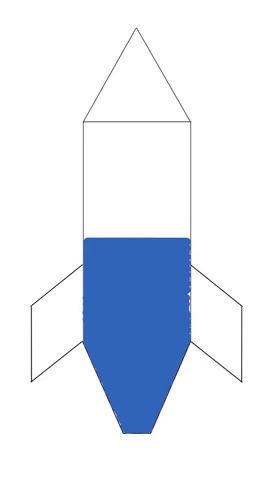What is a Pressurized-Water Rocket?
By: Group K2 - Kevin Finn, Sagar Sachdev and Paul Segovich
An air-water pressurized rocket is a rocket which consists of a 2-liter plastic soda bottle with attached fins for stability and a nosecone to decrease the aerodynamic drag of the rocket during flight. Preparation for launch includes partially filling the soda bottle with a volume of water and subsequently inverting onto the launching platform which has a nozzle and rubber stopper which insert into the bottle. The bottle is then pressurized with air. As the plug is quickly removed, the air expands and forces the water through the opening. This ejection of mass propels the rocket in the opposite direction until the water and pressurized air supply are exhausted.
Got it?
Now, let's take a closer look at what is happening.
NOTE ABOUT ASSUMPTIONS
Throughout this project, we made a variety of assumptions either for simplification or clarity. To keep each subsection tidy and on track, we have opted to attach a list along with descriptions and justification for each under the information tab found here.
SOURCES USED: Citations, [1-5]
WHY WATER??
Pressurized air alone could launch the rocket, so why add water?
The addition of water greatly increases the altitude achievable by the pressurized rocket. The water provides a volume (mass) for the air to press against. This pressure forces the water out (~1s!) before the air escapes. Let's let Bernoulli explain:
That is, for a constant density, streamline flow of an in compressible and inviscid fluid, the energy remains constant at two points in the streamline.

THRUST
Now that we know why there is water, let's try and quantify how it works. For the rocket to accelerate upwards, the volume of liquid must be forced out of the nozzle. Let's let Newton and his third law explain:
"Every force has an equal, and opposite reaction"
In this way, we can now begin to understand what gets the rocket moving. The mass of water is forced out quickly, downwards. The reaction force acts upwards on the rocket, accelerating it. The general formula for thrust:

Let's continue and see what forces act on the rocket during a launch.
Press to launch

FORCES
During flight, there are three main forces which act on the rocket.
-
Thrust
-
Gravity
-
Drag
While accelerating thrust works to overcome the forces of gravity and aerodynamic drag. Once the water and pressurized air are expelled, drag and gravity act to pull the rocket back down.
Let's take a closer look at each of the three primary forces.
Thrust
As discussed before, thrust is a force which is governed by the exhaust velocity, Ve, and the change in mass with time. To quantify thrust, we need to take a closer look at the mechanisms and hydrodynamics which force the water out of the nozzle.
Gravity
Gravity acts on the mass of the rocket and attempts to pull the rocket back to Earth. However, this force varies! As seen with thrust, the mass is changing during the launch and acceleration phase. We need to understand how mass changes with time.
Aerodynamic Drag
Drag is a resisting force (like friction) as a result of the density and pressure of the air that acts on the object moving through it. Drag is greatly affected by velocity of the object, relative to the air, the shape and geometry of the object, and how smooth or rough the surface of the object is.